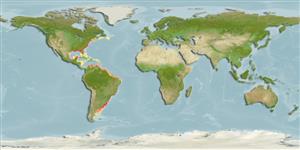Environment: milieu / climate zone / depth range / distribution range
Ecologia
marino; salmastro demersale; oceanodromo (Ref. 51243); distribuzione batimetrica 10 - ? m. Subtropical; 46°N - 51°S
Western Atlantic: Nova Scotia (Ref. 7251) to Florida, Gulf of Mexico, the Antilles (uncommon), and the southern Caribbean coast; also from the Orinoco delta to Argentina.
Length at first maturity / Size / Peso / Age
Maturity: Lm 64.5, range 63 - ? cm
Max length : 170 cm TL maschio/sesso non determinato; (Ref. 7251); common length : 50.0 cm TL maschio/sesso non determinato; (Ref. 3702); peso massimo pubblicato: 51.3 kg (Ref. 4699); Età massima riportata: 43 anni (Ref. 7188)
Spine dorsali (totale): 11; Raggi dorsali molli (totale): 19-22; Spine anali 2; Raggi anali molli: 5 - 7. Silvery grey to very dark, young with 4 or 5 black vertical bars on sides, disappearing with growth; pelvic and anal fins usually dark. Chin with 5 pores and 10 to 13 pairs of small barbels along median edges of lower jaws and subopercles, increasing in length posteriorly. Gas bladder with numerous lateral appendages interconnected in a complicated pattern in adult. Sagitta semicircular and moderately thin (Ref 51721).
Found usually over sand and sandy mud bottoms in coastal waters, especially in areas with large river runoffs. Juveniles often enter estuaries. Feeds mainly on crustaceans, mollusks and fishes.
Robins, C.R. and G.C. Ray, 1986. A field guide to Atlantic coast fishes of North America. Houghton Mifflin Company, Boston, U.S.A. 354 p. (Ref. 7251)
IUCN Red List Status (Ref. 130435)
Threat to humans
Harmless
Human uses
Pesca: commerciale; Pesce da pesca sportiva: si; Acquario: Acquari pubblici
Informazioni ulteriori
CollaboratoriImmaginiStamps, Coins Misc.SuoniCiguateraVelocitàModalità di nuotoArea branchialeOtolithsCervelliVista
Strumenti
Special reports
Download XML
Fonti Internet
Estimates based on models
Preferred temperature (Ref.
123201): 10.8 - 27.6, mean 23.5 °C (based on 326 cells).
Phylogenetic diversity index (Ref.
82804): PD
50 = 1.0000 [Uniqueness, from 0.5 = low to 2.0 = high].
Bayesian length-weight: a=0.00832 (0.00757 - 0.00914), b=3.08 (3.05 - 3.11), in cm total length, based on LWR estimates for this species (Ref.
93245).
Trophic level (Ref.
69278): 3.4 ±0.5 se; based on diet studies.
Resilienza (Ref.
120179): Medio, tempo minimo di raddoppiamento della popolazione 1.4 - 4.4 anni (K=0.17; tm=3-5; tmax=43).
Fishing Vulnerability (Ref.
59153): High vulnerability (60 of 100).
Climate Vulnerability (Ref.
125649): Moderate to high vulnerability (54 of 100).
Nutrients (Ref.
124155): Calcium = 38.1 [22.4, 72.3] mg/100g; Iron = 0.803 [0.422, 1.361] mg/100g; Protein = 19.7 [18.0, 21.7] %; Omega3 = 0.289 [0.175, 0.459] g/100g; Selenium = 37.5 [20.9, 71.1] μg/100g; VitaminA = 4.98 [1.88, 15.13] μg/100g; Zinc = 0.611 [0.443, 0.888] mg/100g (wet weight); based on
nutrient studies.
